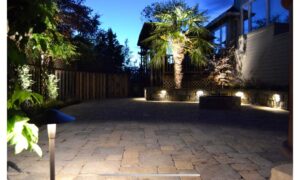Hardscaping is an important part of commercial landscape design. It refers to the non-living elements of a landscape, such as walkways, patios, walls, and water features. Hardscaping can be used to create a variety of effects, from providing functional areas for people to gather to adding visual interest and beauty to a space.
When used effectively, hardscaping can help to create a more inviting and attractive commercial property. It can also help to improve the functionality of a space by providing areas for people to walk, sit, and relax. Hardscaping can also help to improve the safety of a property by providing barriers and security features.
There are a number of factors to consider when planning hardscaping for a commercial property. The first step is to determine the purpose of the hardscaping. Is it to create a functional space, such as a walkway or patio? Or is it to add visual interest and beauty to the space? Once the purpose of the hardscaping is determined, the next step is to select the appropriate materials.
There are a variety of hardscaping materials available, including concrete, stone, brick, and wood. The choice of materials will depend on the desired effect, the budget, and the climate. For example, concrete is a durable material that is well-suited for areas with high traffic. Stone is a natural material that can add a touch of elegance to a space. Brick is a versatile material that can be used to create a variety of effects. Wood is a warm and inviting material that can be used to create a more casual space.
The next step is to design the hardscaping layout. The layout should be functional and aesthetically pleasing. It should also be in keeping with the overall design of the commercial property. The hardscaping layout should also be designed to accommodate the needs of the people who will be using the space. For example, if the hardscaping is for a patio, it should be designed to accommodate tables and chairs.
Once the hardscaping layout is designed, the next step is to install the hardscaping. This is a job that is best left to professionals. Hardscaping installation requires specialized skills and knowledge. It is also important to follow all local building codes when installing hardscaping.
Hardscaping is an important part of commercial landscape design. It can be used to create a variety of effects, from providing functional areas for people to gather to adding visual interest and beauty to a space. When used effectively, hardscaping can help to create a more inviting and attractive commercial property.
Here are some additional tips for using hardscaping in commercial landscape design:
- Choose the right materials. The materials you choose for your hardscaping will have a big impact on the overall look and feel of your landscape. Consider the climate, your budget, and the desired effect when making your selection.
- Plan the layout carefully. The layout of your hardscaping should be functional and aesthetically pleasing. It should also be in keeping with the overall design of your property.
- Hire a professional. Hardscaping installation is a job that is best left to professionals. They will have the skills and knowledge necessary to install your hardscaping properly and safely.
- Maintain your hardscaping. Hardscaping requires regular maintenance to keep it looking its best. Be sure to clean and seal your hardscaping surfaces on a regular basis.
By following these tips, you can create a beautiful and functional commercial landscape that will enhance your property and attract customers.



































